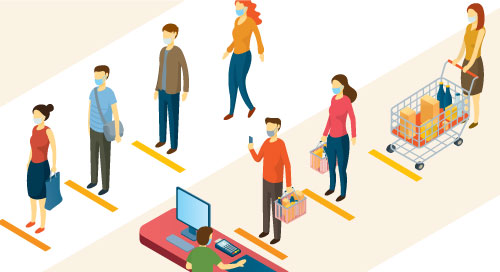AI Enhances Store Safety and the Customer Experience

The pandemic hit retailers with monumental challenges. To safely reopen, they had to shift operations to meet regulations for mask-wearing, social distancing, sanitizing, and other measures. And these health procedures are not simply government demands.
Eighty percent of consumers still feel somewhat unsafe when engaging in out-of-home activities, yet they are increasingly eager to return to normal—and they’re looking for reasons to trust the safety of the stores they visit.
The pandemic has accelerated the move to online shopping, where customers receive highly personalized service. Those who venture into brick-and-mortar stores today are looking not only for a safe environment but for a customer experience that comes closer to their online expectations.
Retail stores must rise to the occasion and meet these new demands—but attempting it with existing systems and limited personnel can be difficult. To enforce health guidelines, they must keep a close watch on every area of the store, a difficult feat even with security cameras in place. Technology solutions that depend on wearable devices or people-counting can help, but adoption can be slow and fraught with snags. Another solution, AI vision, gives retailers an extra pair of eyes, helping to both maintain health regulations and enhance the customer experience.
Eyes on Customer Experience
AI vision works by applying algorithms to security video feed to extract insights. UST Global’s AI video surveillance solution attaches to a store’s existing cameras, enabling rapid deployment and scalability.
The goal of an AI vision solution is to help retail managers understand what is happening in their store without requiring a human to constantly monitor video feeds. The AI engine can look for customer adherence to health guidelines, such as staying six feet apart and wearing face coverings.
But the solution’s monitoring abilities are not limited to a single category. UST Global’s solution offers more than 15 capabilities, including tracking the number of people who enter a store and how long they stay, scanning shelves for items that are out of stock, watching for long checkout lines, and sensing when there’s a problem such as a product spill or a customer who has slipped and fallen.
Can AI keep customers safe and happy? @USTGlobal sees great promise in vision systems. via @insightdottech
The system uses UST Global software and Intel solutions such as the Intel® OpenVINO™ toolkit. It doesn’t use facial recognition technology or track individual identity, gender, or ethnicity. All data stays within the solution, usually installed as a node inside the store rather than traveling to a remote cloud. Information is aggregated and processed at the edge, where store managers can use it. Once AI models are in place, they can monitor the data through a mobile app or a dashboard in the store.
Some stores may also choose to display a data dashboard for customers to view, a gesture that can add to their sense of safety as they see how many people are in the store at a given time, for example. If the solution detects a problem—for instance, a customer who’s not wearing a mask—it will immediately send an email or text alert to store managers.
Once the solution is deployed, retailers can easily adjust the parameters of AI models. For example, a manager can change customer social-distancing alerts from six feet apart to nine feet apart by adjusting the software. Managers can add other AI models by training and testing their cameras on new data.
Also, video data is not stored. Instead, alerts or notifications are created based on what the video revealed—a product was out of stock at a particular time, for example—and those alerts are sent up the chain to central management.
A Versatile Solution
AI vision technology is valuable in many fields besides retail. In manufacturing, it can inspect parts for quality assurance without human intervention, and monitor factory workers to ensure their safety and health. AI models can also be tuned to track highly customized processes, such as the assembly and cleaning of sensitive medical instruments.
Ultimately, AI vision solutions hold out tremendous promise for enhancing retail customer experiences and increasing efficiencies across industries. “It’s non-intrusive, quick to deploy, and not dependent on procuring a lot of additional hardware,” says Gopal Rallapalli, technical account manager/GTM lead at UST Global. “This technology is going to play a major role in the future of retail.”